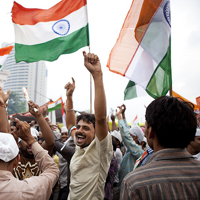From the start of 2011 to the year’s end, corruption dominated India's headlines and enflamed public opinion like no other issue. Three developments in particular brought corruption to the fore. First, in late-2010, the office of India's comptroller and auditor general released a report stating that the Indian exchequer had lost more than $20 billion in revenue in the auction process allocating 2G telecommunications airwaves. Second, a 70-year-old Gandhi-esque figure led an anti-corruption movement that captured the nation’s attention and garnered global coverage. Third, an increasing number of India's powerful elite began calling the country’s most famous prison, Tihar jail, home. All three developments, along with a few others, managed to keep the issue of corruption in the spotlight throughout the year.
Corruption in India
Few Indians are spared from the tentacles of corruption, which pervades the everyday life of everyone from the poorest farmer to the richest businessman. For the poor, access to government services comes at a price. Only a fraction of the government’s direct disbursements for social welfare programs, including food subsidies and housing allowances, actually reach their intended recipients. The rest is siphoned off by a leaky distribution system in which bureaucrats and middlemen, such as distribution agents for food grains, take a piece of the pie.

